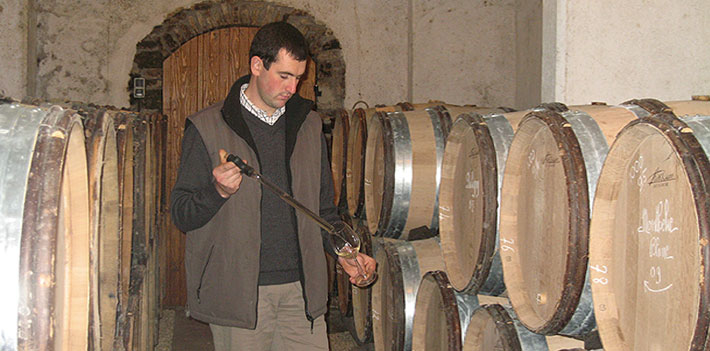Domaine Potinet-Ampeau
Vincent Durrieu is the fifth generation of this family to work the domain, continuing with very traditional Burgundian methods. And it’s a noble tradition.
The Domaine Potinet-Ampeau is one of very few to make wine meant to be laid downand to hold vintages in their own cellars to allow them to age correctly before release.
The family had strong ties to the American market as early as the 1920s, when Vincent’s grandmother’s family, winemakers in Meursault, were among the first to export to the US. And it was Vincent’s grandparents who, in 1951, started keeping ‘vins de garde’, so the domain always has an impressive array of older vintages on offer.
The Domaine Potinet-Ampeau is situated in the village of Monthelie in the southern part of the Cote de Beaune, near to Meursault, Volnay and Auxey-Duresses.The domain works 21.5 acres and produces as much red as white in appellations in the villages of Puligny-Montrachet, Meursault, Auxey-Duresses, Volnay, Pommard and Monthelie. The vines are on average 30 years old, and the vineyards are plowed (without herbicides) and treated reasonably with natural compounds.
Vinification
The majority of the harvest is done by hand. Vinification takes place entirely in their cellars. Red grapes are sorted in the field at the moment they are picked if need be. Most ‘cuvees’ are then de-stemmed and crushed. A traditional maceration of at least 17 days takes place in tanks that maintain the temperature at 12C for the first few days in order to extract the maximum of Pinot Noir aromas. Each tank is pumped over regularly and punched down occasionally. In certain years, a final warm maceration is allowed to take place. In years where the natural sugar are low, the must is chaptalized, meaning sugar is added. Recent Burgundy vintage have rarely needed to be chaptalized, however.
Alcoholic fermentation for the reds takes place naturally with the addition of yeast or enzymes. The marc is then pressed (mechanical press). Then the wine is left to settle out for 24 hours before being sent down to barrels in the cellars by gravity. Whites are pressed directly (mechanical press). The musts are left to settle for 24 hours and chaptalized if necessary. They are they taken down to barrels in the cellars by gravity. They are maintained at a temperature of 20 C to allow the alcoholic fermentation to take off. This temperature also permits the wines to keep subtle aromas. Generally this fermentation takes place slowly, over several weeks.
The wines are raised in Allier oak barrels. The maximum proportion of new oak is 30% per year. Whites receive a ‘batonnage’ every 2 weeks until the malolactic fermentation finishes, usually during the following spring.

‘Battonage’ allows the lees to remain in suspension, nourishing the wine and making it ‘fat’. Once the malo is finished, the wines are racked and returned to the barrels.The maturation of the whites lasts 16-22 months. For the reds, maturation lasts 16-18 months. For all of these wines, the final stage is done in tanks where the various barrels of each appellation are assembled to ensure a consistent, pure ‘cuvee’. The wines are then bottled at the domain by a specialist bottling company after having been fined and filtered (for the whites), or lightly filtered (for the reds).
The bottled wine is then aged in their excellent cellars where the elements necessary for conservation are ideal and naturally present (humidity, temperature). They then wait for the time to be right. Most of the production goes to export and to individual clients. A part of the production each year is kept in reserve for long aging before being sold when they are mature.
Appellations
White
- Bourgogne Blanc
- Bourgogne Aligote
- Monthelie
- Meursault
- Meursault ‘Les Rougeots’
- Puligny-Montrachet
- Puligny-Montrachet 1er Cru ‘Les Champs Gains’
- Meursault 1er Cru ‘Les Charmes’
- Meursault 1er Cru ‘Les Perrieres’
- Meursault 1er Cru ‘Pourusot’
Red
- Monthelie
- Volnay
- Monthelie 1er Cru ‘Les Champs-Fulliots’
- Monthelie 1er Cru ‘Les Riottes’
- Auxey-Duresses 1er Cru ‘Les Duresses’
- Volnay 1er Cru ‘Les Santenots’
- Volnay 1er Cru ‘Clos des Chenes’
- Volnay 1er Cru ‘Les Carelles’
- Pommard 1er Cru ‘Les Pezerolles’